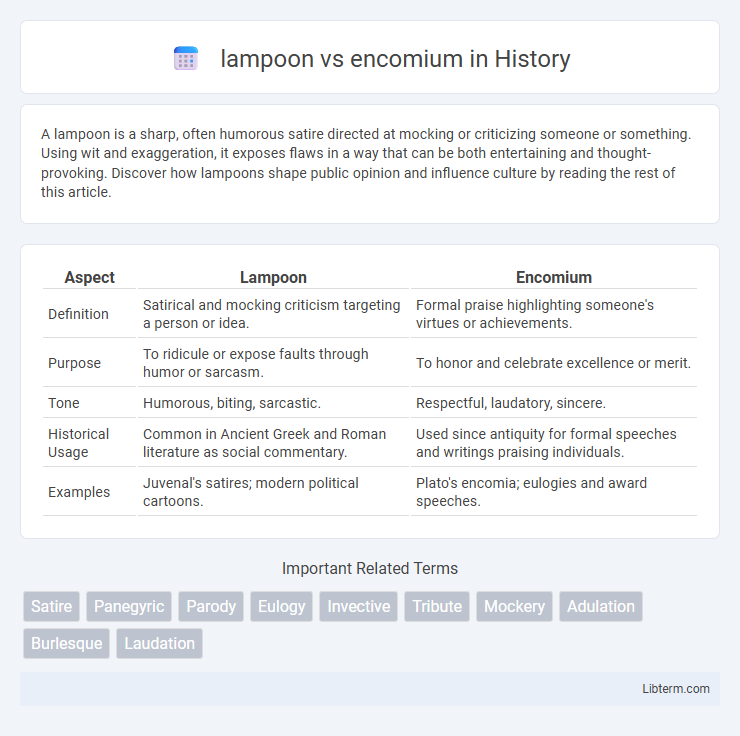A lampoon is a sharp, often humorous satire directed at mocking or criticizing someone or something. Using wit and exaggeration, it exposes flaws in a way that can be both entertaining and thought-provoking. Discover how lampoons shape public opinion and influence culture by reading the rest of this article.
Table of Comparison
| Aspect | Lampoon | Encomium |
|---|---|---|
| Definition | Satirical and mocking criticism targeting a person or idea. | Formal praise highlighting someone's virtues or achievements. |
| Purpose | To ridicule or expose faults through humor or sarcasm. | To honor and celebrate excellence or merit. |
| Tone | Humorous, biting, sarcastic. | Respectful, laudatory, sincere. |
| Historical Usage | Common in Ancient Greek and Roman literature as social commentary. | Used since antiquity for formal speeches and writings praising individuals. |
| Examples | Juvenal's satires; modern political cartoons. | Plato's encomia; eulogies and award speeches. |
Understanding Lampoon and Encomium
Lampoon is a sharply satirical or mocking piece aimed at ridiculing its subject, often using humor to expose flaws or shortcomings. Encomium is a formal expression of praise that celebrates the virtues, achievements, or qualities of a person or thing, typically delivered in a laudatory tone. Understanding the contrast between lampoon and encomium highlights the difference between criticism rooted in irony and admiration based on genuine respect.
Etymology and Historical Origins
Lampoon traces back to the French word "lampon," meaning to drink, evolving into a form of sharp satire targeting public figures since the 17th century. Encomium originates from the Greek word "enkomion," which referred to a song of praise performed at celebrations, dating to classical antiquity. Both terms reveal their societal roles: lampoon serves as ironic critique, while encomium expresses formal commendation.
Core Features of a Lampoon
A lampoon is a sharply satirical piece of writing or art that uses humor, irony, and exaggeration to ridicule or criticize a person, group, or institution, often with the intent of exposing flaws or hypocrisy. Core features of a lampoon include its biting tone, exaggerated caricatures, and the use of sarcasm to provoke amusement or reflection. Unlike an encomium, which praises and celebrates its subject, a lampoon aims to mock and highlight shortcomings through pointed, often humorous commentary.
Characteristics of an Encomium
An encomium is a formal expression of high praise characterized by laudatory language that highlights the virtues, achievements, and positive qualities of its subject. It often employs elevated diction, emotive appeals, and structured arguments to inspire admiration and convey respect or honor. Unlike a lampoon, an encomium aims to uplift and celebrate, making it a key rhetorical device in ceremonies and commemorations.
Tone and Intent: Satire vs. Praise
A lampoon employs a sarcastic, mocking tone intended to expose flaws or ridicule its subject through humor and irony, making satire its core purpose. An encomium, in contrast, uses an elevated, sincere tone designed to praise and celebrate someone's virtues or achievements, aiming to honor and commend. The intent of a lampoon is often critical and confrontational, whereas an encomium seeks admiration and positive recognition.
Famous Lampoons in Literature
Famous lampoons in literature include Jonathan Swift's "A Modest Proposal," which sharply satirizes social and political issues through biting irony. Mark Twain's works, such as "The Adventures of Huckleberry Finn," use lampoon to ridicule societal norms and hypocrisy. Lampoon differs from encomium by employing humor and ridicule to criticize, whereas encomium offers praise and commendation.
Renowned Encomiums in History
Encomiums are formal expressions of praise that celebrate notable figures and achievements, often immortalized in historical speeches and writings such as Cicero's praise of Julius Caesar. Renowned encomiums highlight virtues and accomplishments, reinforcing societal values and inspiring admiration, exemplified by Martin Luther King Jr.'s "I Have a Dream" speech, which honored civil rights leaders and ideals. Unlike lampoons, encomiums uphold respect and honor, serving as powerful tools for commemoration and motivation throughout history.
Lampoon and Encomium in Modern Media
Lampoon and encomium serve distinct functions in modern media; lampoon acts as a satirical tool that mocks individuals, institutions, or social norms through humor and irony, often seen in political cartoons, late-night comedy shows, and online memes. Encomium, in contrast, functions as a formal praise or tribute, prominently featured in award speeches, celebrity profiles, and promotional content aiming to highlight achievements and positive attributes. Understanding their use enhances media literacy by recognizing how content either criticizes or celebrates its subjects through contrasting rhetorical approaches.
When to Use Lampoon or Encomium
Use a lampoon when aiming to criticize or mock a person, group, or idea with humor, satire, or irony to highlight flaws or shortcomings. Employ an encomium to express formal praise or admiration during speeches, ceremonies, or written tributes that celebrate accomplishments or virtues. Choosing between lampoon and encomium depends on the intent to either denounce through ridicule or honor through exaltation.
Impact on Audience and Society
Lampoon uses satire and humor to criticize and expose flaws, often provoking laughter or discomfort that can inspire social reflection or change through ridicule. Encomium employs praise and admiration to elevate subjects, fostering respect, motivation, and reinforcing positive values within a community. Both forms significantly shape public opinion, with lampoon challenging norms while encomium upholds societal ideals.
lampoon Infographic

 libterm.com
libterm.com